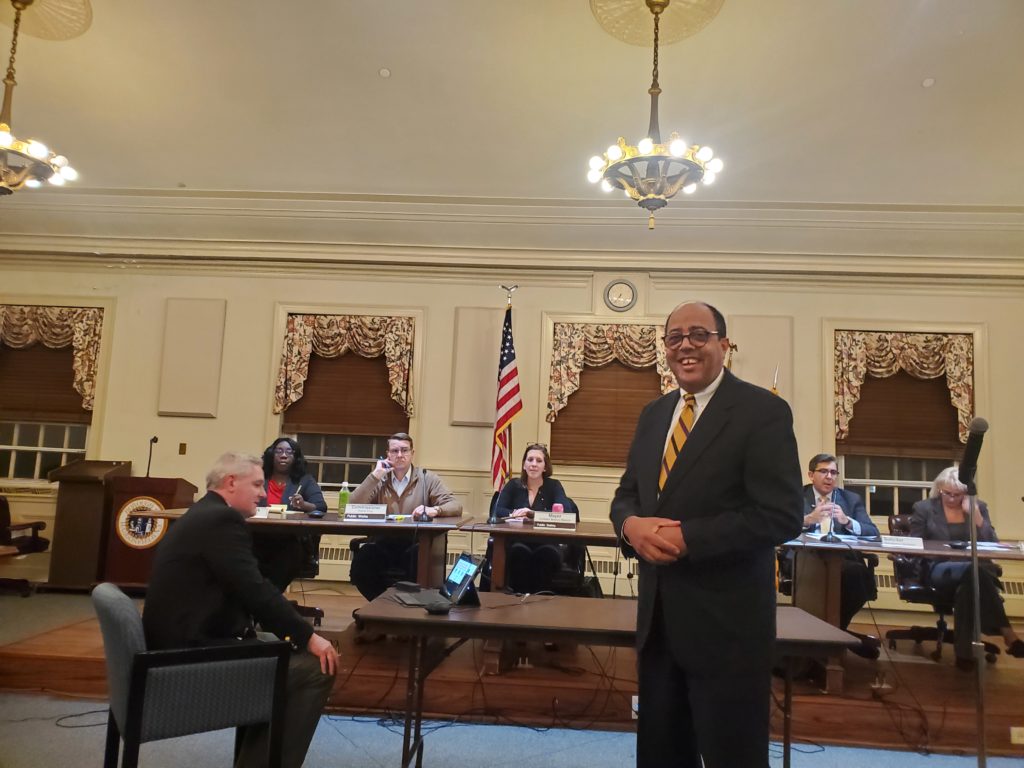
Manitou consultant Charles Jennings (right) reported to borough commissioners his company’s findings for the LEAP study on alternative ways for Haddonfield, Haddon Heights and Barrington to work together on EMS and fire services.
Consultants who recently evaluated opportunities for shared services and how models are working in the Haddonfield, Haddon Heights and Barrington fire companies and EMS services presented their findings to borough commissioners on Dec. 4.
The survey by New York-based Manitou Inc. was funded by a $75,000 Local Efficiency Achievement Program grant.
“Essentially, in this study, we were asked to provide a series of alternatives and our recommendations, their feasibility and costs, so we view the study as a decision resource for the borough,” said Charles Jennings, co-founder of Manitou.
“I think it’s fairly clear in the study that we feel that the status quo as it is now is not sufficient in the long term, and that there is going to be need for some sort of additional supports for fire response that the borough can appeal.”
Jennings’s survey overview reported on the status of shared opportunities and working models in the three towns. In January, Barrington and Haddon Heights’ fire services merged into the Haddon Heights-Barrington Fire Department under a single chief, with career staff operating from Barrington’s station and volunteers from Haddon Heights.
Jennings noted that Barrington and Haddon Heights’ stations were close to each other and could be merged into one, but that was not the case for Haddonfield, and “having a single station to serve three boroughs was not desirable.”
Manitou’s study presented three options: Use the current model of consolidating fire and EMS into a single agency; have options if there were dual-role or single-role fire and EMS employees; and have Haddonfield contract out to another agency for service.
Jennings highlighted some things that needed to be resolved within the current model, including low daytime staffing, the need for 24-hour coverage – that more than any stipend program is designed to handle – and possible extension of the stipend program.
With the second option, he noted there would be both short- and long-term goals if the boroughs were to combine fire and EMS into one organization, including legal and governance options, determination of costs and enactment of agreements, the appointment of a full-time chief and development of personnel policies and coverage assignments across three boroughs.
The third option involved developing contracts with bordering municipalities to provide fire, EMS or both services to Haddonfield and performing annual performance reviews per benchmarks in the contracts.
Costs for option one would be an additional $165,000 per year for Haddonfield; option two costs would range from $2.65 million to $4.1 million per year depending on factors such as whether or not to combine EMS and fire services or if the services are running 24/7 five days a week. There were no cost estimates for option three due to the bilateral negotiations that would result.
The commissioners made no decisions or recommendations on the survey, but Mayor Colleen Bianco Bezich noted that next steps would include the creation of a small committee of individuals with experience and relationship to EMS and fire services to meet and report feedback and recommendations after a 30-to-45-day period.
The hope is to make a decision on a path forward – whether interim, short-term (one to three years) or longer-term – by the end of the first quarter of 2024, with implementation in quarter two or quarter three.
Although the consultant report looked at three municipalities, Bianco Bezich reiterated that the commissioners are not limited to the options in the study and they don’t need to work with the other municipalities on solutions, though they could decide to.
One of the reasons the mayor pursued the grant for the study was to address the shortage of fire and EMS volunteers, many of whom live outside the borough and, as a result, take longer to respond to calls.
“When you have a career department or people in the fire house waiting, people are immediately there and able to get dressed and get on the rig,” Bianco Bezich noted, “and you cut your response time down significantly.”
She also shared the fact that the borough over the years has often lost volunteer firefighters to retirement or to paid career firefighting, and any recruiting solution would likely come at a cost to taxpayers.
“My obligation is to make Haddonfield a safe place to live and respond,” Bianco Bezich insisted. “I’m really optimistic about reaching conclusions that will benefit us in the short term and hopefully the long term, to provide for the safety of our residents, to make us a safer community and to provide a primary fire response that meets the standards we need to uphold.
” … That can be done with any number of combinations, and we just have to be smart about how we spend our dollars and how we utilize our shared services.”
The full consultant report can be requested through borough hall or by emailing the clerk.


